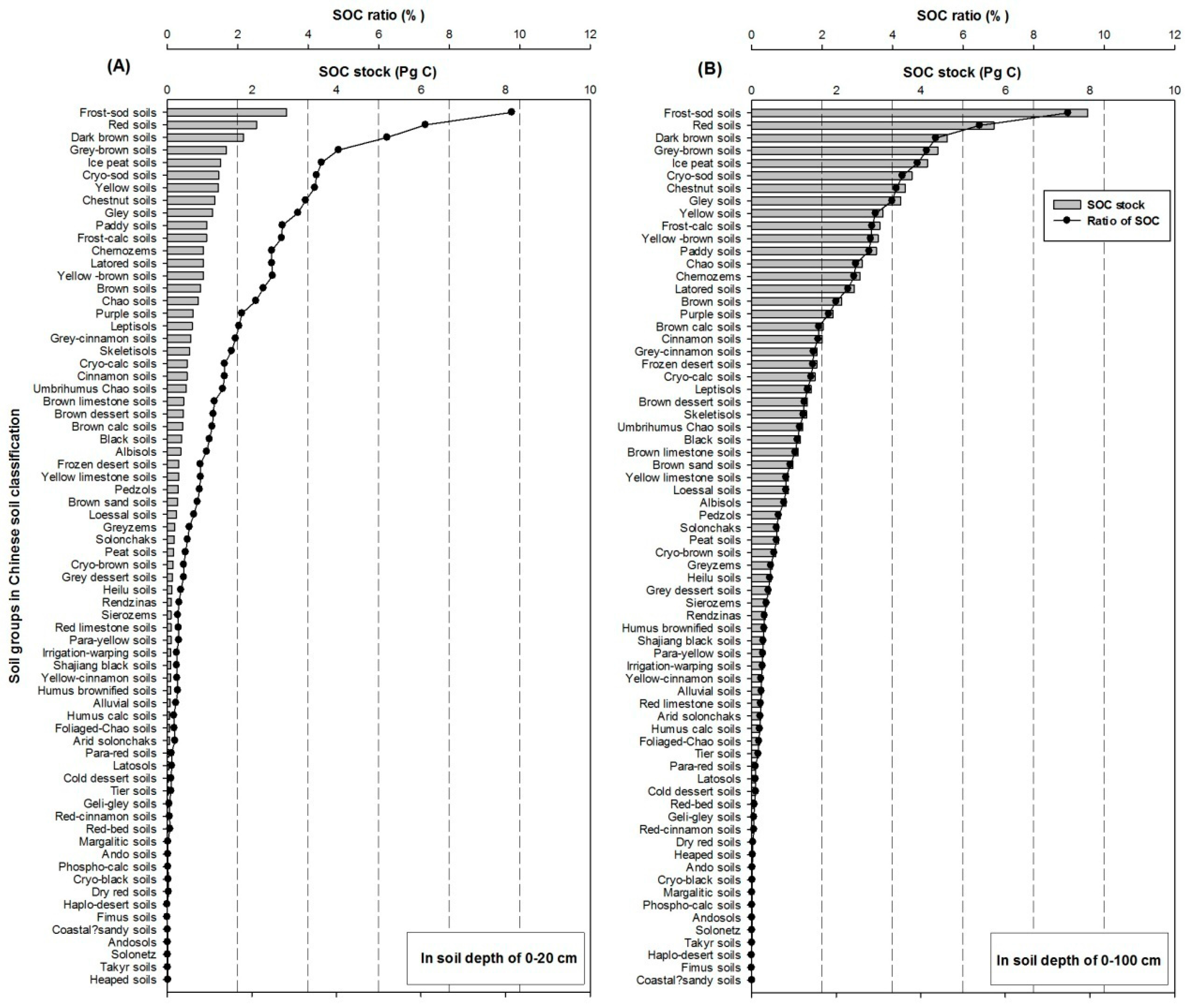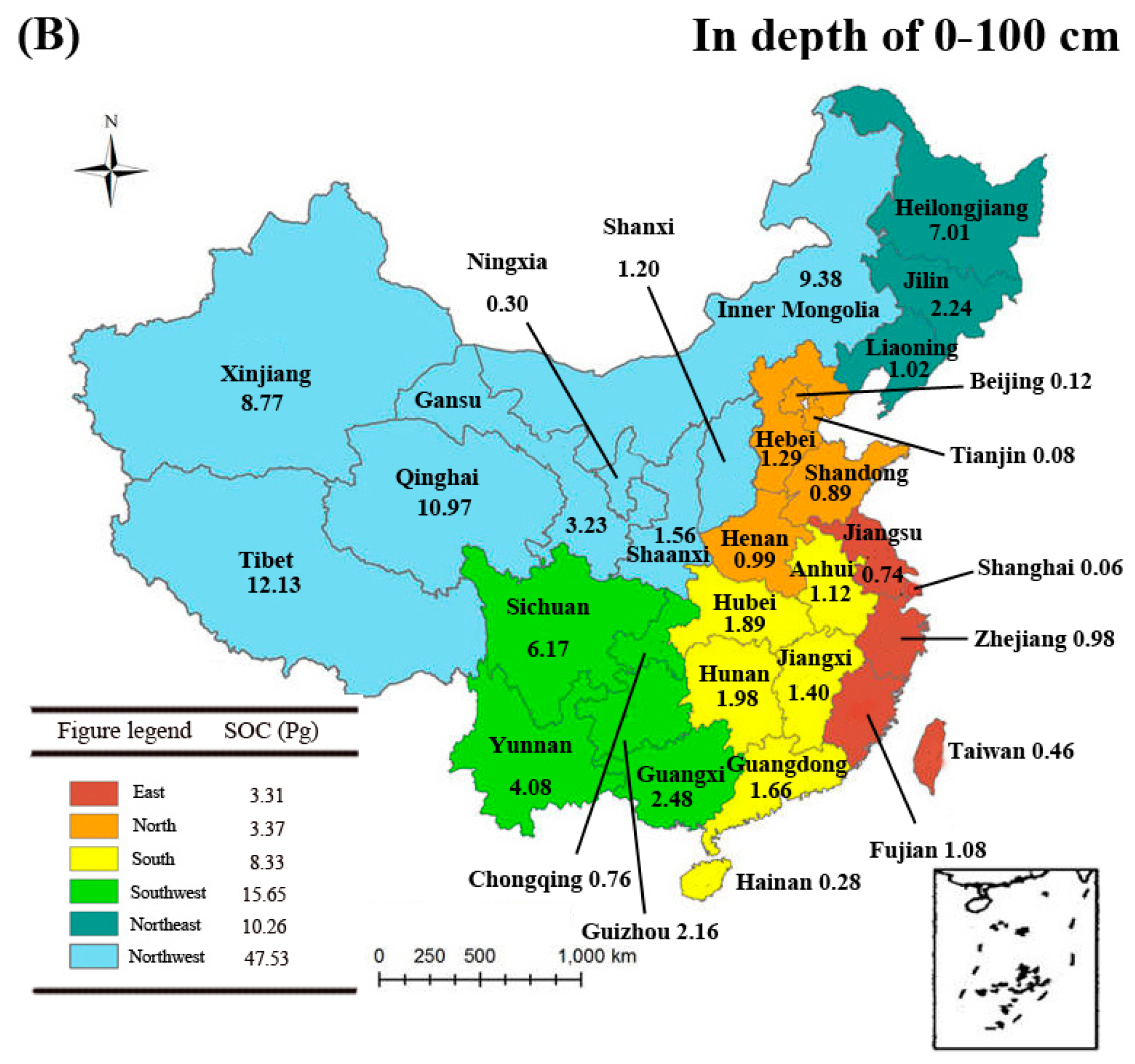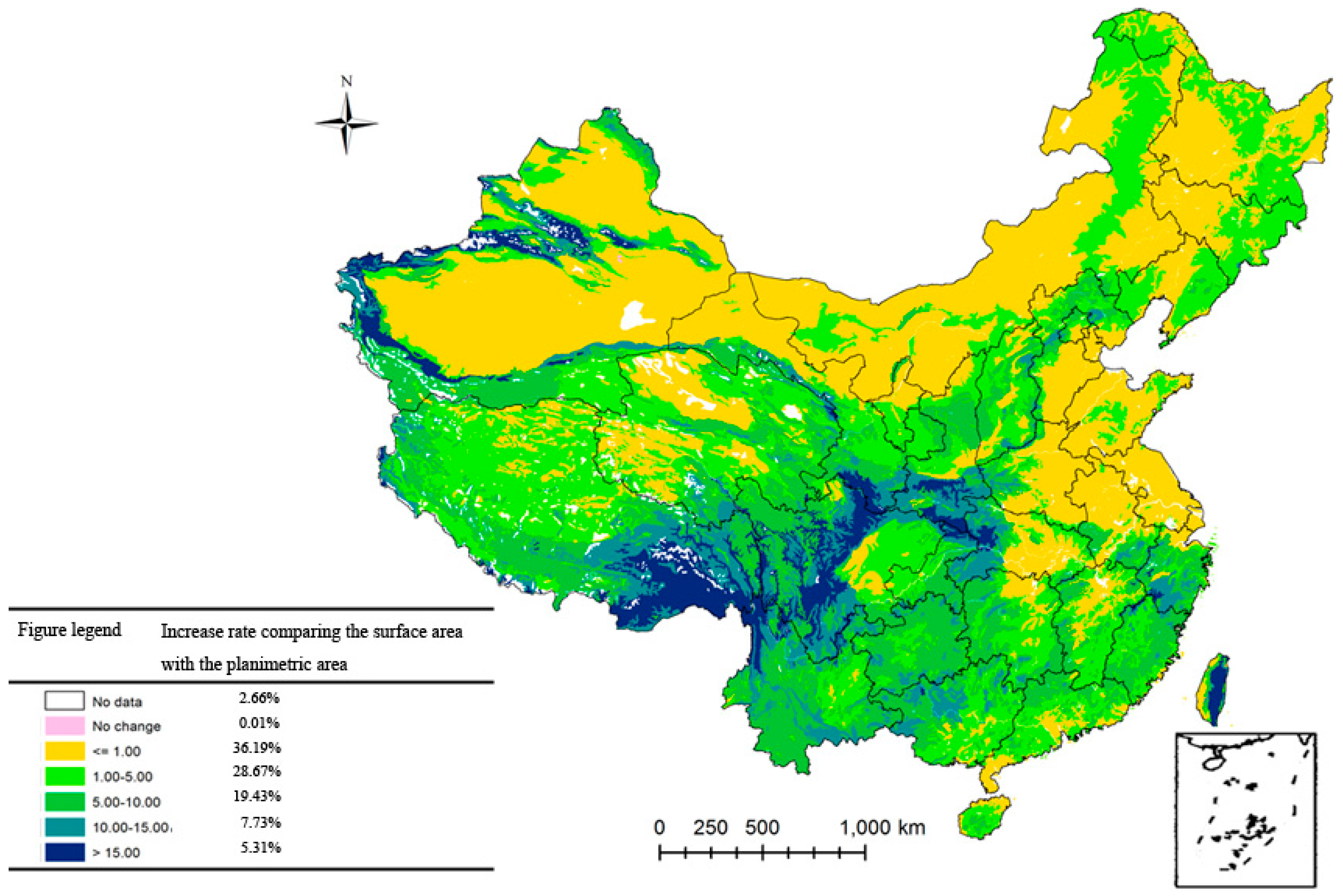Soil Organic Carbon Stocks in Terrestrial Ecosystems of China: Revised Estimation on Three-Dimensional Surfaces
Abstract
:1. Introduction
2. Materials and Methods
2.1. Soil Data Source
2.2. Surface Area Calculation
2.3. Estimates of Soil Organic Carbon Stocks
2.4. Statistical Analysis
3. Results
3.1. Area Distribution Calculated from 3-D Surfaces
3.2. SOC Stocks Estimated on 3-D Surfaces
3.3. The Relationships between the 3-D Surface Area and the Two SOC Metrics
4. Discussion
4.1. Area Estimations on 2-D and 3-D Surfaces
4.2. SOC Stock Estimated on 3-D Surfaces in Different Soil Groups of China
4.3. SOC Stock Estimated on 3-D Surfaces in Different Regional Provinces of China
4.4. Future Work Suggestions
5. Conclusions
Acknowledgments
Author Contributions
Conflicts of Interest
References
- Gregg, J.S.; Andres, R.J.; Marland, G. China: Emissions pattern of the world leader in CO2 emissions from fossil fuel consumption cement production. Geophys. Res. Lett. 2008, 35, 1–5. [Google Scholar] [CrossRef]
- Piao, S.L.; Fang, J.Y.; Ciais, P.; Peylin, P.; Huang, Y.; Sitch, S.; Wang, T. The carbon balance of terrestrial ecosystems in China. Nat. Lett. 2009, 458, 1009–1015. [Google Scholar] [CrossRef] [PubMed]
- Choudhury, S.G.; Srivastava, S.; Singh, R.; Chaudhari, S.K.; Sharma, D.K.; Singh, S.K.; Sarkar, D. Tillage residue management effects on soil aggregation, organic carbon dynamics yield attribute in rice–wheat cropping system under reclaimed sodic soil. Soil Tillage Res. 2014, 136, 76–83. [Google Scholar] [CrossRef]
- Luo, Z.; Wang, E.; Sun, O.J. Can no-tillage stimulate carbon sequestration in agricultural soils? A meta-analysis of paired experiments. Agric. Ecosyst. Environ. 2010, 139, 224–231. [Google Scholar] [CrossRef]
- Ogle, S.M.; Swan, A.; Paustian, K. No-till management impacts on crop productivity, carbon input soil carbon sequestration. Agric. Ecosyst. Environ. 2012, 149, 37–49. [Google Scholar] [CrossRef]
- Meersmans, J.; van Wesemael, B.; de Ridder, F.; van Molle, M. Modelling the three-dimensional spatial distribution of soil organic carbon (SOC) at the regional scale (Flander, Belgium). Geoderma 2009, 152, 43–52. [Google Scholar] [CrossRef]
- Pilaš, I.; Kušan, V.; Medved, I.; Bakšic, N.; Marjanovic, H. Estimation of soil organic carbon stocks stock changes in Croatia (1980–2006)—Use of national soil database the Corine L Cover. Period. Biol. 2013, 115, 339–347. [Google Scholar]
- Pan, G.X. Study on soil organic inorganic carbon of China. Bull. Sci. Technol. Soc. 1999, 15, 330–332. (In Chinese) [Google Scholar]
- Wang, S.Q.; Zhou, C.H.; Li, K.R.; Zhu, S.L.; Huang, F.H. Analysis on spatial distribution characteristics of soil organic carbon reservoir in China. Acta Geogr. Sin. 2000, 55, 533–543. (In Chinese) [Google Scholar]
- Wang, S.Q.; Zhou, C.H.; Li, K.R. Estimation of soil organic carbon reservoir in China. J. Geogr. Sci. 2001, 11, 3–12. [Google Scholar]
- Wu, H.B.; Guo, Z.T.; Peng, C.H. Distribution storage of soil organic carbon in China. Glob. Biogeochem. Cycles 2003, 17, 1–13. [Google Scholar] [CrossRef]
- Wu, H.B.; Guo, Z.T.; Peng, C.H. Land use induced changes of organic carbon storage in soils of China. Glob. Chang. Biol. 2003, 9, 305–315. [Google Scholar] [CrossRef]
- Xie, X.L.; Sun, B.; Zhou, H.Z.; Li, Z.P.; Li, A.B. Organic carbon density storage in soils of China spatial analysis. Acta Pedol. Sin. 2004, 41, 35–43. (In Chinese) [Google Scholar]
- Li, Z.P.; Han, F.X.; Su, Y.; Zhang, T.L.; Sun, B.; Monts, D.L.; Plodinec, M.J. Assessment of soil organic carbonate carbon storage in China. Geoderma 2007, 138, 119–126. [Google Scholar] [CrossRef]
- Yu, D.S.; Shi, X.Z.; Sun, W.X.; Wang, H.J.; Liu, Q.H.; Zhao, Y.C. Estimation of China soil organic carbon storage density based on 1:1000000 soil database. Chin. J. Appl. Ecol. 2005, 16, 2279–2283. (In Chinese) [Google Scholar]
- Yu, D.S.; Shi, X.Z.; Wang, H.J.; Sun, W.X.; Warner, E.D.; Liu, Q.H. National Scale Analysis of Soil Organic Carbon Storage in China Based on Chinese Soil Taxonomy. Pedosphere 2007, 17, 11–18. [Google Scholar] [CrossRef]
- Wei, S.G.; Dai, Y.J.; Liu, B.Y.; Zhu, A.X.; Duan, Q.Y.; Wu, L.Z.; Ji, D.Y.; Ye, A.Z.; Yuan, H.; Zhang, Q.A. China data set of soil properties for land surface modeling. J. Adv. Model. Earth Syst. 2013, 5, 212–224. [Google Scholar]
- Xie, Z.B.; Zhu, J.G.; Liu, G.; Cadisch, G.; Hasegawa, T.; Chen, C.; Sun, H.F.; Tang, H.Y.; Zeng, Q. Soil organic carbon stocks in China changes from 1980s to 2000s. Glob. Chang. Biol. 2007, 13, 1989–2007. [Google Scholar] [CrossRef]
- Hole-Filled SRTM for the Globe Version 4, the CGIAR-CSI SRTM 90 m Database. Available online: http://srtm.csi.cgiar.org (accessed on 7 April 2008).
- Jenness, J.S. Calculating landscape surface area from digital elevation models. Wildl. Soc. Bull. 2004, 32, 829–839. [Google Scholar] [CrossRef]
- Li, W.H.; Gong, J.H. Quantitative simulation for difference between true surface area planimetric area. Appl. Res. Comput. 2008, 25, 983–985. (In Chinese) [Google Scholar]
- McGarigal, K.; Tagil, S.; Cushman, S.A. Surface metrics: an alternative to patch metrics for the quantification of landscape structure. Landsc. Ecol. 2009, 24, 433–450. [Google Scholar] [CrossRef]
- Zhang, Z.M.; van Coillie, F.; de Wulf, R.; de Clercq, E.M.; Ou, X.K. Comparison of surface planimetric landscape metrics for mountainous land cover pattern quantification in Lancang Watershed, China. Mt. Res. Dev. 2012, 32, 213–225. [Google Scholar]
- Zhang, Y.; Zhao, Y.C.; Shi, X.Z.; Lu, X.X.; Yu, D.S.; Wang, H.J.; Sun, W.X.; Darilek, J.L. Variation of soil organic carbon estimates in mountain regions: A case study from Southwest China. Geoderma 2008, 146, 449–456. [Google Scholar] [CrossRef]
- Batjes, N.H. Total carbon nitrogen in the soils of the world. Eur. J. Soil Sci. 1996, 47, 151–163. [Google Scholar] [CrossRef]
- Zhou, H.Z. Sharing of soil information data distributed inquiry data base of 1:4 M soil information of China. Acta Pedol. Sin. 2002, 39, 483–489. [Google Scholar]
- ESRI ArcScript. Available online: http://arcscripts.esri.com/ (accessed on 1 August 2013).
- Li, W.; Mao, L.; Bo, M. Incorporating topography in a cellular automata model to simulate residents evacuation in a mountain area in China. Phys. A Stat. Mech. Its Appl. 2013, 392, 520–528. [Google Scholar]
- Sun, R.H.; Zhang, B.P.; Chen, L.D. Regional-scale identification of three-dimensional pattern of vegetation landscapes. Chin. Geogr. Sci. 2014, 24, 104–112. [Google Scholar] [CrossRef]
- Hoffman, U.; Yair, A.; Hikel, H.; Kuhn, N.J. Soil organic carbon in the rocky desert of northern Negev (Israel). J. Soils Sediments 2012, 12, 811–825. [Google Scholar] [CrossRef]
- Olson, K.R. Soil organic carbon sequestration, storage, retention loss in US croplands: Issues paper for protocol development. Geoderma 2013, 195, 201–206. [Google Scholar] [CrossRef]





| SOC Stock (Pg) | Number of Soil Profiles | References |
|---|---|---|
| Data source from China Soil Map at the scale of 1:4 M | ||
| 92.4 | 2473 | Wang et al. [9,10] |
| 70.3 | 34,411 | Wu et al. [11,12] |
| 84.4 | 2456 | Xie et al. [13] |
| 83.8 | 2456 | Li et al. [14] |
| Data source from China Soil Map at the scale of 1:1 M | ||
| 89.1 | 7292 | Yu et al. [15,16] |
| 72.5 | 8979 | Wei et al. [17] |
| Data source from soil series of China | ||
| 50.0 | 2500 | Pan [8] |
| 89.6 | 2473 | Xie et al. [18] |
| Soil Groups in Chinese Soil Classification | Soil Area | SOCD (kg·m−2) | ||
|---|---|---|---|---|
| Distribution (104 km2) | Ratio (%) | Depth of 0–20 cm | Depth of 0–100 cm | |
| Red soils | 69.41 | 7.21 | 3.04 | 8.25 |
| Brown sand soils | 65.66 | 6.82 | 0.38 | 1.49 |
| Frost-calc soils | 58.92 | 6.12 | 1.59 | 5.14 |
| Brown dessert soils | 55.52 | 5.77 | 0.68 | 2.38 |
| Chao soils | 45.11 | 4.69 | 1.61 | 5.81 |
| Frost-sod soils | 40.45 | 4.2 | 6.96 | 19.64 |
| Frozen desert soils | 37.06 | 3.85 | 0.73 | 4.15 |
| Cryo-sod soils | 36.09 | 3.75 | 3.39 | 10.5 |
| Chestnut soils | 35.43 | 3.68 | 3.19 | 10.27 |
| Dark brown soils | 30.6 | 3.18 | 5.87 | 15.12 |
| Yellow soils | 30.57 | 3.18 | 3.95 | 10.25 |
| Paddy soils | 30.18 | 3.14 | 3.12 | 9.79 |
| Purple soils | 28.96 | 3.01 | 2.11 | 6.68 |
| Yellow-brown soils | 26.55 | 2.76 | 3.24 | 11.22 |
| Skeletisols | 26.42 | 2.74 | 1.99 | 4.93 |
| Brown calc soils | 26.3 | 2.73 | 1.4 | 6.28 |
| Latored soils | 25.61 | 2.66 | 3.34 | 9.47 |
| Brown soils | 25.14 | 2.61 | 3.12 | 8.46 |
| Cinnamon soils | 23.86 | 2.48 | 1.97 | 7 |
| Leptisols | 23.55 | 2.45 | 2.5 | 5.98 |
| Chernozems | 19.5 | 2.03 | 4.38 | 13.17 |
| Loessal soils | 19.23 | 2 | 1.14 | 4.51 |
| Gley soils | 16.16 | 1.68 | 6.62 | 21.83 |
| Solonchaks | 12.51 | 1.3 | 1.34 | 5.02 |
| Grey-brown soils | 11.89 | 1.23 | 11.78 | 37 |
| Cryo-calc soils | 11.64 | 1.21 | 4.03 | 12.88 |
| Grey-cinnamon soils | 9.23 | 0.96 | 6.04 | 16.84 |
| Grey dessert soils | 8.46 | 0.88 | 1.59 | 5.06 |
| Black soils | 8.4 | 0.87 | 4.1 | 13.7 |
| Brown limestone soils | 7.85 | 0.82 | 4.92 | 14.16 |
| Albisols | 7.79 | 0.81 | 4.15 | 10.8 |
| Umbrihumus Chao soils | 6.89 | 0.72 | 6.58 | 17.62 |
| Yellow limestone soils | 6.41 | 0.67 | 4.27 | 13.56 |
| Sierozems | 6.11 | 0.63 | 1.42 | 6.1 |
| Cold dessert soils | 6.07 | 0.63 | 0.52 | 1.72 |
| Heilu soils | 5.98 | 0.62 | 1.86 | 7.75 |
| Cryo-brown soils | 5.6 | 0.58 | 2.42 | 10.12 |
| Shajiang black soils | 5.03 | 0.52 | 1.56 | 5.78 |
| Yellow-cinnamon soils | 4.44 | 0.46 | 1.82 | 6.21 |
| Arid solonchaks | 3.85 | 0.4 | 1.62 | 5.75 |
| Alluvial soils | 3.75 | 0.39 | 1.92 | 6.51 |
| Pedzols | 3.39 | 0.35 | 7.78 | 27.63 |
| Foliaged-Chao soils | 3.1 | 0.32 | 1.83 | 6.13 |
| Irrigation-warping soils | 3.05 | 0.32 | 2.54 | 8.88 |
| Greyzems | 2.95 | 0.31 | 6.19 | 16.54 |
| Humus calc soils | 2.44 | 0.25 | 2.26 | 8.35 |
| Ice peat soils | 2.36 | 0.25 | 53.46 | 176.46 |
| Tier soils | 2.13 | 0.22 | 1.53 | 7.93 |
| Red limestone soils | 1.94 | 0.2 | 4.77 | 11.71 |
| Para-red soils | 1.93 | 0.2 | 1.86 | 5.11 |
| Rendzinas | 1.49 | 0.15 | 6.56 | 22.17 |
| Red-bed soils | 1.48 | 0.15 | 1.46 | 4.82 |
| Para-yellow soils | 1.31 | 0.14 | 7.18 | 21.48 |
| Humus brownified soils | 1.18 | 0.12 | 7.2 | 27.04 |
| Red-cinnamon soils | 1.13 | 0.12 | 1.69 | 5 |
| Latosols | 1.06 | 0.11 | 3.53 | 8.85 |
| Takyr soils | 0.85 | 0.09 | 0.27 | 1.19 |
| Dry red soils | 0.68 | 0.07 | 1.58 | 4.91 |
| Peat soils | 0.54 | 0.06 | 27.91 | 115.93 |
| Coastal sandy soils | 0.3 | 0.03 | 0.55 | 1.57 |
| Solonetz | 0.22 | 0.02 | 1.02 | 2.99 |
| Geli-gley soils | 0.15 | 0.02 | 12.31 | 40.27 |
| Ando soils | 0.15 | 0.02 | 3.74 | 11.18 |
| Heaped soils | 0.14 | 0.01 | 3.64 | 19.55 |
| Cryo-black soils | 0.11 | 0.01 | 8.07 | 15.29 |
| Andosols | 0.11 | 0.01 | 1.69 | 7.04 |
| Haplo-desert soils | 0.1 | 0.01 | 0.47 | 1.21 |
| Margalitic soils | 0.09 | 0.01 | 6.1 | 14.51 |
| Phospho-calc soils | 0.05 | 0.01 | 12.67 | 16.49 |
| Fimus soils | 0.04 | 0 | 3.5 | 10.35 |
| Total | 962.62 | 100 | ||
| Region | Provinces | Area (×104 km2) | Regional Sum (×104 km2) |
|---|---|---|---|
| South | Anhui | 14.30 | 94.62 |
| Hubei | 19.54 | ||
| Jiangxi | 17.27 | ||
| Hunan | 22.09 | ||
| Guangdong | 18.00 | ||
| Hainan | 3.43 | ||
| Southwest | Chongqing | 8.86 | 147.68 |
| Sichuan | 53.36 | ||
| Guangxi | 25.02 | ||
| Guizhou | 18.83 | ||
| Yunnan | 41.63 | ||
| East | Jiangsu | 9.70 | 37.98 |
| Shanghai | 0.67 | ||
| Fujian | 12.78 | ||
| Zhejiang | 10.93 | ||
| Taiwan | 3.90 | ||
| North | Hebei | 19.13 | 54.22 |
| Henan | 16.86 | ||
| Shandong | 15.38 | ||
| Beijing | 1.71 | ||
| Tianjin | 1.13 | ||
| Northeast | Jilin | 19.41 | 79.82 |
| Liaoning | 14.75 | ||
| Heilongjiang | 45.66 | ||
| Northwest | Gansu | 42.22 | 574.60 |
| Inner Mongolia | 115.24 | ||
| Ningxia | 5.27 | ||
| Qinghai | 74.22 | ||
| Shanxi | 16.25 | ||
| Shaanxi | 22.00 | ||
| Tibet | 128.73 | ||
| Xinjiang | 170.66 | ||
| Total | 988.93 |
| Increase Rate (%) | Soil Class Number | Average Elevation (m) |
|---|---|---|
| 0–1 | 24 | 876.86 |
| 1–5 | 22 | 1174.67 |
| 5–10 | 17 | 1655.33 |
| >10 | 8 | 2829.59 |
© 2016 by the authors; licensee MDPI, Basel, Switzerland. This article is an open access article distributed under the terms and conditions of the Creative Commons Attribution (CC-BY) license (http://creativecommons.org/licenses/by/4.0/).
Share and Cite
Zhou, R.; Pan, X.; Wei, H.; Xie, X.; Wang, C.; Liu, Y.; Li, Y.; Shi, R. Soil Organic Carbon Stocks in Terrestrial Ecosystems of China: Revised Estimation on Three-Dimensional Surfaces. Sustainability 2016, 8, 1003. https://doi.org/10.3390/su8101003
Zhou R, Pan X, Wei H, Xie X, Wang C, Liu Y, Li Y, Shi R. Soil Organic Carbon Stocks in Terrestrial Ecosystems of China: Revised Estimation on Three-Dimensional Surfaces. Sustainability. 2016; 8(10):1003. https://doi.org/10.3390/su8101003
Chicago/Turabian StyleZhou, Rui, Xianzhang Pan, Hongxu Wei, Xianli Xie, Changkun Wang, Ya Liu, Yanli Li, and Rongjie Shi. 2016. "Soil Organic Carbon Stocks in Terrestrial Ecosystems of China: Revised Estimation on Three-Dimensional Surfaces" Sustainability 8, no. 10: 1003. https://doi.org/10.3390/su8101003





